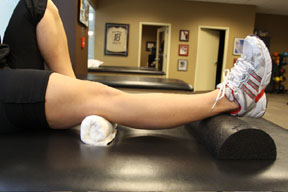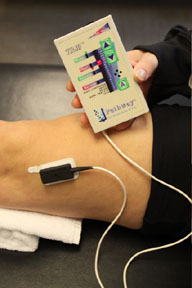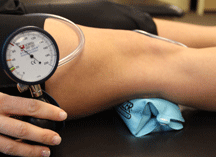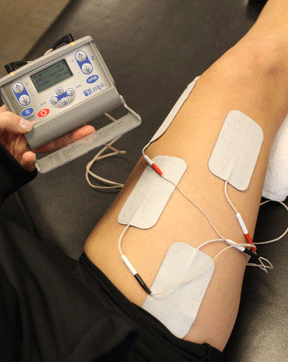Dr Dirk Kokmeyer explains how to get the quads muscles firing again after a period of knee immobilisation.
 First published 2007, and reviewed August 2023 by Dr Sheila Strover (Clinical Editor)
First published 2007, and reviewed August 2023 by Dr Sheila Strover (Clinical Editor)
Arthrofibrosis Rehab Tutorials
- Principles of arthrofibrosis rehabilitation
- Patellar Mobilisation
- Restoring quad function
While you make small gains with passive mobility, you will need to support those gains with an active support system.
This means muscle strength. The quadriceps muscles extend the knee. When a long-standing ROM limitation is present, the muscle fibers will adapt by shortening. When you make gains in passive mobility, the muscle must re-adapt to a new length. Quad-setting to maximal extension will help to maintain the gains you make with stretches, mobilizations and passive mobility.
It has been shown that as little at 20ml of joint swelling can cause inhibition of the quadriceps muscles. It is imperative to continue the PRICE protocol to ensure optimal quad function. (ref. 1) See chapter 1 for instructions."
Quad Sets
Place your knee as straight as you can (full extension) and tighten your quadriceps muscles to actively straighten the knee. Some helpful tricks to assist with maximal recruitment of your quads are:
- Elevate your leg with a large towel roll under your ankle and a smaller one under your knee. The small towel roll will give you a reaction force to encourage a stronger quad contraction while offering enough give to encourage knee extension.
- Begin with 20 repetitions of 10 seconds each. For a greater challenge, try to quad set for 1 minute sets. That’s right! Hold your muscle as tight as you can for one whole minute. Try 5 sets of this. We have had great results!
- Contract the quads on your other leg. A cross-over effect may help to get your involved side contracting.
- Consider the use of a biofeedback device or neuromuscular electric stimulation (NMES) device.
Straight Leg Raises
Initially, we begin with quad sets to restore active knee extension. Once you achieve full extension (or at least extension to 0º), you can try a straight leg raise (SLR). Do this by quad-setting to ‘lock-out’ the knee and then lift your leg off the ground approximately 6 inches. This requires significant effort from the quads to maintain straightness against the weight of the lower leg. Activity from the hip flexors in lifting the leg may help to facilitate increased quad activity as well. A helpful trick to achieving a perfect SLR is to lean back half way and engage your abdominal muscles as if you are trying to pull your knee cap into your stomach.
NMES and Biofeedback
NMES is a form of electric stimulation used to assist in strengthening muscles. Electrodes are placed on the skin over the muscle you wish to strengthen. When the intensity of the device is increased, it stimulates an action potential, which elicits involuntary firing of muscle fibers. In general, NMES has been shown to be an effective adjunct to restoring quad strength. (ref 2)
A biofeedback – or surface EMG - uses visual and audible feedback to encourage muscle activity. By placing a sensory electrode on the skin over the muscle, the device will sense muscle activity. When the muscle is contracted, the device will beep and illuminate lights on a meter. A harder contraction will cause the device to beep harder and illuminate more lights. The threshold of the device can be changed increase the difficulty level.
Both devices have been shown to be effective in training the quadriceps muscles (ref. 3,4), and in one study, biofeedback was determined superior to NMES (ref. 4).
Since the NMES can take some getting used to and is uncomfortable to some, biofeedback may be more appropriate. I use both devices in my practice and remain unbiased with both.
References
1. Torry M, Decker M, Millett PJ, Steadman R, Sterett WI. “The Effects of knee joint effusion on quadriceps electromyography during jogging.” Journal of Sports Science and Medicine 2005; 4, 1-8.
2. Bax L, Staes F, Verhagen A. “Does neuromuscular electrical stimulation strengthen the quadriceps femoris? A systematic review of randomised controlled trials.” Sports Med. 2005;35(3):191-212.
3. Draper V. “Electromyographic biofeedback and recovery of quadriceps femoris muscle function following anterior cruciate ligament reconstruction” Physical Therapy 1990 Jan;70(1):11-17.
4. Draper V, Ballard L “Electrical stimulation versus electromyographic biofeedback in the recovery of quadriceps femoris muscle function following anterior cruciate ligament surgery.” Physical Therapy 1991 Jun;71(6):455-461.
PREVIOUS PART: Patellar Mobilisation
END



 ...In the clinic, we have also used a “Stabilizer” to act as a feedback device. A folded up blood pressure cuff works equally as well. Elevate and support the knee under the ankle and place the inflated device under your knee. Quad setting to maximal extension will register more pressure on the device, making it challenging to achieve maximal extension.
...In the clinic, we have also used a “Stabilizer” to act as a feedback device. A folded up blood pressure cuff works equally as well. Elevate and support the knee under the ankle and place the inflated device under your knee. Quad setting to maximal extension will register more pressure on the device, making it challenging to achieve maximal extension.
